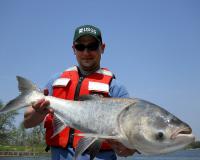
Vibrant Environment
All | Biodiversity | Climate Change and Sustainability | Environmental Justice | Governance and Rule of Law | Land Use and Natural Resources | Oceans and Coasts | Pollution Control

Cities, the U.S. military, and private businesses are increasingly turning to artificial intelligence and analytical tools as they strive for greater resiliency amid growing incidents of climate-related flooding, heat waves, and other extreme events. In January, participants in the Environmental Law Institute’s 9th GreenTech webinar—“Technology and Climate Resiliency”—discussed these developments and the incentives for adoption of cutting-edge tools and various impediments.

This column is indeed my “closing statement.” This past January, I officially stepped down from my role as president to take up residence with my wife in Rome. I will continue working with the Institute from Europe on a part-time basis, primarily supporting ELI’s international portfolio. The balance of my time will be devoted to working with the consultancy Sustainability Frameworks.

The environment got a big boost last September when a rocket blasting off from Vandenberg Air Force Base orbited Landsat 9. The new satellite is a highly instrumented space probe designed to scrutinize the Earth from aloft with visual images and an array of other sensors. Test photos taken shortly after launch showed outstanding resolution of the biosphere unrolling below.

Global plastics production doubled over the last two decades, and is predicted to double again in the next two decades. Increased production has led to increased waste. Ocean plastics pollution is rising, and the ocean will likely contain more plastics mass than fish by 2050.

Part III of this four-part blog series discussed common shortcomings to avoid in developing climate plans and examined two instances of legal challenges to county plans in California.


Part I of this four-part blog series provided an overview of local climate planning and elements common to most plans. This article distinguishes the components of a mitigation plan from those of an adaptation plan.

Local governments can play a critical role in reducing greenhouse gas (GHG) emissions and preparing their communities for projected climate change impacts. These governments are well-positioned to assess local climate hazards and risks, identify opportunities to reduce GHG emissions, and engage the community in identifying priorities. Crucially, they are the first responders to public health emergencies and extreme weather events and possess powerful tools over land use and the built environment.

Part 1 of this two-part blog series explored the history and current use of carbon, capture, and storage (CCS). Part 2 discusses the policy challenges that limit CCS use and how these policies can be improved to expand it.
The biggest question is: if CCS can reduce carbon dioxide emissions so drastically, why isn’t everyone implementing it?
